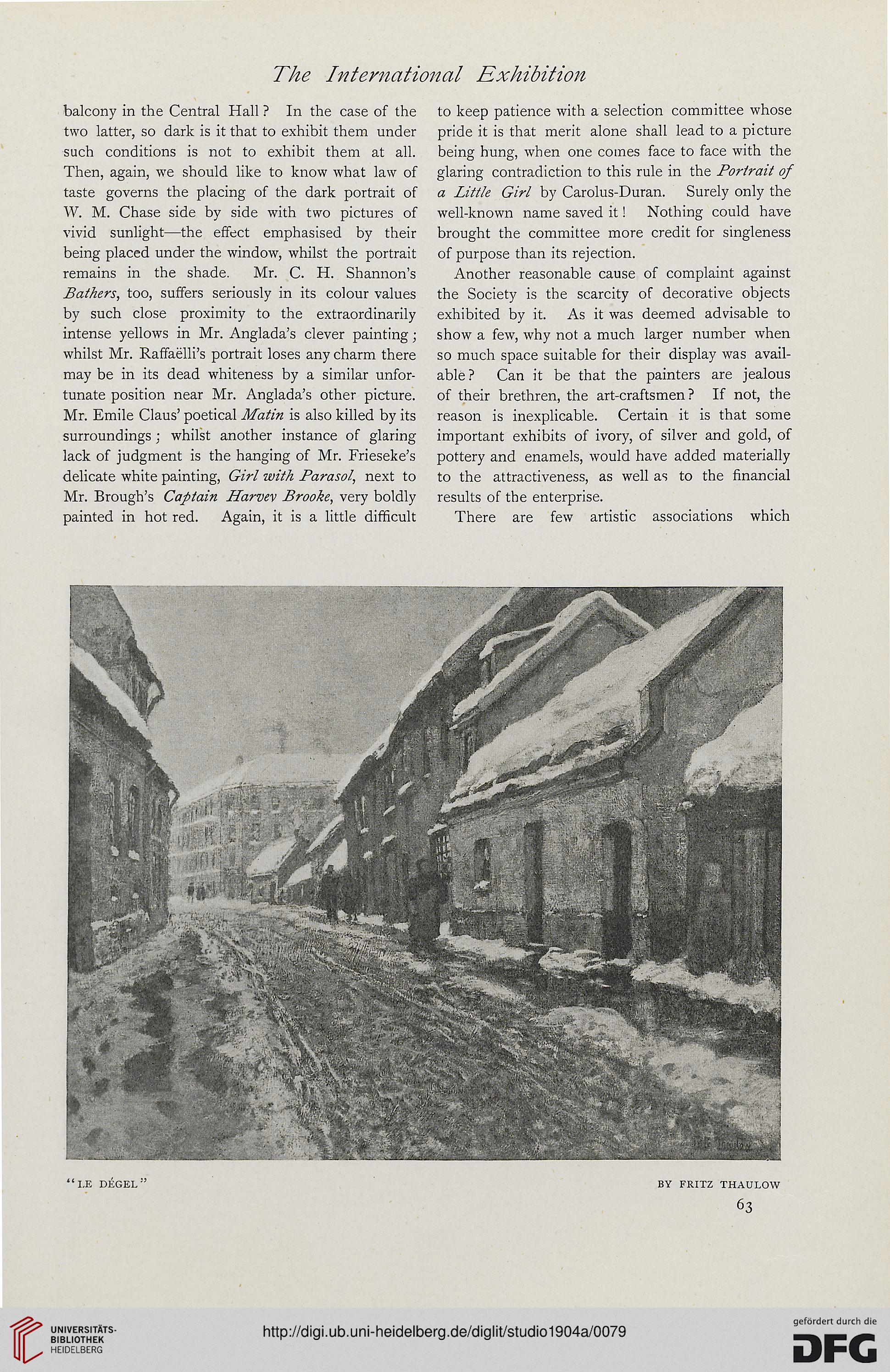The International Exhibition
balcony in the Central Hall ? In the case of the
two latter, so dark is it that to exhibit them under
such conditions is not to exhibit them at all.
Then, again, we should like to know what law of
taste governs the placing of the dark portrait of
W. M. Chase side by side with two pictures of
vivid sunlight—the effect emphasised by their
being placed under the window, whilst the portrait
remains in the shade. Mr. C. H. Shannon's
Bathers, too, suffers seriously in its colour values
by such close proximity to the extraordinarily
intense yellows in Mr. Anglada's clever painting;
whilst Mr. Raffaelli's portrait loses any charm there
may be in its dead whiteness by a similar unfor-
tunate position near Mr. Anglada's other picture.
Mr. Emile Claus' poetical Matin is also killed by its
surroundings ; whilst another instance of glaring
lack of judgment is the hanging of Mr. Frieseke's
delicate white painting, Girl with Parasol, next to
Mr. Brough's Captain Harvev Brooke, very boldly
painted in hot red. Again, it is a little difficult
to keep patience with a selection committee whose
pride it is that merit alone shall lead to a picture
being hung, when one comes face to face with the
glaring contradiction to this rule in the Portrait of
a Little Girl by Carolus-Duran. Surely only the
well-known name saved it! Nothing could have
brought the committee more credit for singleness
of purpose than its rejection.
Another reasonable cause of complaint against
the Society is the scarcity of decorative objects
exhibited by it. As it was deemed advisable to
show a few, why not a much larger number when
so much space suitable for their display was avail-
able ? Can it be that the painters are jealous
of their brethren, the art-craftsmen? If not, the
reason is inexplicable. Certain it is that some
important exhibits of ivory, of silver and gold, of
pottery and enamels, would have added materially
to the attractiveness, as well as to the financial
results of the enterprise.
There are few artistic associations which
LE DEGEL BY FRITZ THAULOW
63
balcony in the Central Hall ? In the case of the
two latter, so dark is it that to exhibit them under
such conditions is not to exhibit them at all.
Then, again, we should like to know what law of
taste governs the placing of the dark portrait of
W. M. Chase side by side with two pictures of
vivid sunlight—the effect emphasised by their
being placed under the window, whilst the portrait
remains in the shade. Mr. C. H. Shannon's
Bathers, too, suffers seriously in its colour values
by such close proximity to the extraordinarily
intense yellows in Mr. Anglada's clever painting;
whilst Mr. Raffaelli's portrait loses any charm there
may be in its dead whiteness by a similar unfor-
tunate position near Mr. Anglada's other picture.
Mr. Emile Claus' poetical Matin is also killed by its
surroundings ; whilst another instance of glaring
lack of judgment is the hanging of Mr. Frieseke's
delicate white painting, Girl with Parasol, next to
Mr. Brough's Captain Harvev Brooke, very boldly
painted in hot red. Again, it is a little difficult
to keep patience with a selection committee whose
pride it is that merit alone shall lead to a picture
being hung, when one comes face to face with the
glaring contradiction to this rule in the Portrait of
a Little Girl by Carolus-Duran. Surely only the
well-known name saved it! Nothing could have
brought the committee more credit for singleness
of purpose than its rejection.
Another reasonable cause of complaint against
the Society is the scarcity of decorative objects
exhibited by it. As it was deemed advisable to
show a few, why not a much larger number when
so much space suitable for their display was avail-
able ? Can it be that the painters are jealous
of their brethren, the art-craftsmen? If not, the
reason is inexplicable. Certain it is that some
important exhibits of ivory, of silver and gold, of
pottery and enamels, would have added materially
to the attractiveness, as well as to the financial
results of the enterprise.
There are few artistic associations which
LE DEGEL BY FRITZ THAULOW
63




